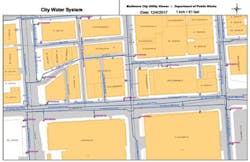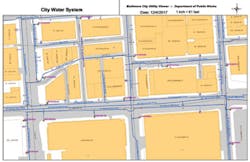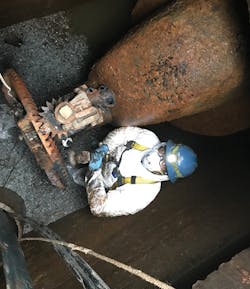Baltimore City: Pioneering Water Infrastructure Reliability
By Carlos A. Espinosa and Cliff Wilson
In 2004, Baltimore launched its valve assessment and repair program to locate and map over 64,000 valves and 22,000 hydrants. Today, the program remains strong and supports the city’s strategic goal of a sustainable and reliable water infrastructure. Baltimore’s vision was ahead of its time and paved the way for other utilities in the United States to embrace the concept of proactive maintenance coupled with a Geographical Information System (GIS).
Baltimore has over a decade of proactive asset management experience, managing large and critical valves as a central component. The city provides water to several surrounding counties and serves over 1.8 million people. Dealing with a very old infrastructure (average age over 80 years) requires a proactive management approach. It just makes good business sense to assess the current operability level and to determine where to invest in upgrades.
In addition, increasing valve operability from an initial 60 percent to the current 90 percent level, field crews have access to GPS positions and operational history, and can update functional status into Baltimore’s GIS and the Computerized Maintenance Management System (CMMS). These systems ensure that asset information is accessible in an emergency and provide valuable data for planning system upgrades.
Some aspects of the program paid immediate dividends. The field crews determined that 5 percent of pressure boundary valves had been inadvertently left open. Closing these valves restored the proper hydraulic grade lines and positively impacted system operation. One pump station saw a significant decrease in the pumping required, which translated into energy savings.
Another benefit is the city’s ability to respond to emergencies faster and more efficiently, thus minimizing the impact to the customers. If the closest valves to a water main break are not operating or you can’t find them, you have to step back to the next valve available. As you do that, your footprint gets bigger and more customers get impacted. Staying on top of the valves minimizes the impact and footprint of any shutdown because you can do it faster and more economically.
One incident in 2009 demonstrated the value of the program. The Dundalk transmission main suffered a catastrophic break when the 72-inch prestressed concrete pipe burst near a busy intersection, flooding the area with 175,000 gallons per minute and threatening 6,000 homes. Thanks to the information system and the high level of operability, it was clear which crews to deploy and where, as well as the specific sequence in which to shut down the main. Through the valve assessment and maintenance program, Baltimore was able to isolate the break faster and lessen the impact.
The information system has allowed Baltimore’s crews to be more effective. Using a field application (Utility Viewer or UView, see Fig. 1), crews can access GIS maps and locate hydrants and valves via mobile devices like iPads and iPhones.
Figure 1. With the Utility Viewer, crews can access GIS maps and locate hydrants and valves via mobile devices.
Some advice to other utilities thinking of implementing a proactive asset management program:
1. Don’t wait. Get started.
2. Don’t expect that it will be perfect from the get go. You can adjust as you go.
3. A robust GIS system will make it easier to track, store, and access information.
Regulating Asset Management
New Jersey’s Water Quality Accountability Act, passed in June 2017, is an example of a state regulating proactive valve asset management. It requires the development of an asset management plan to routinely inspect, maintain and repair water infrastructure. It mandates inspections of valves, with the frequency determined by valve size. It also requires testing and flushing of fire hydrants. The locations of both valves and hydrants must be digitally mapped into a GIS-compatible format. Whether New Jersey’s regulated program is the best approach for all utilities could be debated, but in the absence of utilities taking the initiative, such regulations are likely to become more common.
Guidance Emphasizes Consequences of Failure
Both the American Water Works Association (AWWA) and the Water Research Foundation (WRF) assert that utilities should not wait for states to require asset management but should develop asset management programs as an aspect of good management principles. Both have issued guidance that can be used to systematically develop a proactive valve management system.
The AWWA M-44 Manual advocates for developing a buried asset management program that considers both dynamic valve (point) assets and static pipelines (line) assets. M-44 encourages annual inspection of large and critical valves and advocates for a risk based approach where:
Risk = Consequences of Failure (CoF) X Probability of Failure
Look to the Triple Bottom Line
The WRF report 4451, Managing Infrastructure Risk: The Consequence of Failure for Buried Assets, asserts that some of the underfunding of buried assets may be the result of the current methods of assessing consequences that focus solely on the direct costs to the utility. This report stressed that utilities need to create a “complete” business case for investment by expanding the understanding of the consequences of failure. WRF 4451 advocates a triple bottom line (TBL) approach that considers:
1. Fiscal impacts borne directly by the utility and other agencies;
2. Societal impacts borne by customers and the community, including property damage, transit delays, disruptions to businesses and service outages; and,
3. Environmental impacts to sensitive areas.
As Figure 2 shows, this triple bottom line can be two to four times the direct cost to the utility alone. The WRF estimates the TBL geometric mean cost for all breaks to be $42,000; however, for the top 10 percent of the costliest failures, the geometric mean cost is over $1 million. The WRF estimates that the collateral damage from a break is 50 percent or more of the triple bottom line.
The WRF stresses that focusing on the TBL may assist utilities in justifying an investment in asset condition assessment and buried asset management. The WRF approach advocates proactively assessing and managing assets with a high CoF, then looking for ways to reduce risks through condition assessment (CA) and the rehabilitation, repair and replacement of high CoF assets, where the CA indicates a need. For assets with a lower CoF, the WRF report suggests a more reactive stance would be reasonable. Such an approach would maximize the impact of investment while minimizing liability for cost-effective management. WRF Report 4451 contains appendices and work sheets that can be utilized as tools for developing a program for condition assessment based on the CoF.
Factors Contributing to the Consequences of Failure
The WRF determined that pipe diameter alone was not a main driving factor in the TBL of consequences of failure. A small line can have a large CoF. Consider a small diameter pipe in a dense, urban setting, with high value/critical customers like hospitals or other institutions, and where a break will cause considerable damage as well as major traffic disruptions. Likewise, the age of the pipe was not necessarily an accurate indicator of condition or potential for failure. The main factors driving a high CoF are:
• Location
• Duration and spatial footprint of a break
• Limited redundancy of supply
• Mode of failure (e.g., an explosive burst versus a slower leak)
In the WRF’s research, location and duration/spatial footprint were the two factors that had the greatest impact on the overall CoF. Of these two, duration/spatial footprint can be effectively addressed and minimized through a valve assessment and rehabilitation program. Beginning an assessment program with the evaluation and remediation of the valves provides a base for controlling the impacts of a break. By prioritizing valve assessment and rehabilitation/repair for valves near high CoF locations, the proactive program can address the highest factors economically and cost effectively.
Critical valves control vital water transmission lines — the backbone of any water system. Their operability is essential for controlling a water system and ensuring system reliability. Operable critical valves reduce the consequences when large diameter pipeline failures occur.
Return on Investment
WRF 4451 describes valve placement and operation as “a critical component of buried asset risk management.” Proactive buried asset management often begins with a valve assessment program as a key component for system control for managing risk. This system control focuses on how quickly a water main break can be isolated and the impacts minimized by reducing the duration and spatial footprint of a break. In many cases, a valve assessment program that improves the ability to locate a critical valve and improves the operability of the systems’ valves delivers a high return on investment (ROI) by providing improved responsiveness and control during a break.
WRF 4451 provides a link to an online valve assessment ROI calculator developed by Wachs Water Service to determine if starting a valve asset management program might be cost effective for your utility.
Valve Assessment Program: The Two Prongs of Success
A successful valve assessment program focuses on two types of assets. The physical asset of the valve addresses its current usability, i.e., whether the valve can be located, accessed and operated. All three are essential for a usable valve. The information asset provides information for planning and emergency response. Having accessible, accurate, meaningful information assets helps field staff quickly respond to an emergency to reduce the CoF.
Good Business Sense
As Baltimore — and many other utilities — will tell you, a good buried asset management program more than pays for itself, not only for risk management and reducing the CoF of a break but also as a planning tool for expanding the knowledge of your system and for planning capital projects. To take control of your system’s assets, it makes sense to start with the control points: large and critical valves.
Experienced partners can bring expertise to both finding and repairing assets, have specialized tools for enhancing location accuracy down to the sub-meter level, and can assist in setting up a sustainable program to identify both the physical valve assets and the information assets and how valves protect the system. Proactive planning empowers you to control the consequences of failure by controlling the duration and footprint of a break.
So, the questions you must ask yourself are:
• Can you quickly and efficiently respond to a break in any part of your system?
• Would your crews know exactly what valves were operational and the sequence in which they should be closed to prevent damage to other areas of your system and to minimize both the duration of flow and the footprint of impact?
• Do you have an ongoing program in place to keep both your physical assets in optimal operating condition and your informational assets accurate, meaningful and accessible?
Our buried assets aren’t getting any younger. You owe it to your utility and your customers to be proactive and develop an asset management program for your future and theirs. It really does pay big dividends well into the future. WW
About the Authors: Carlos A. Espinosa, P.E., is chief of asset management for Baltimore City DPW. He has 36 years of experience in the design, operation and evaluation of water, stormwater, and wastewater systems. He holds engineering degrees from the U.S. Naval Academy and from Johns Hopkins University. He is a registered professional engineer in various Mid-Atlantic states.
Cliff Wilson is president of Wachs Water Services, a division of Pure Technologies US Inc. He has over 30 years of experience in the water, oil, and technologies industries and is an expert in water distribution system asset management and information management. He graduated with an engineering degree from the U.S. Naval Academy and earned his MBA from the Darden Business School at the University of Virginia.



